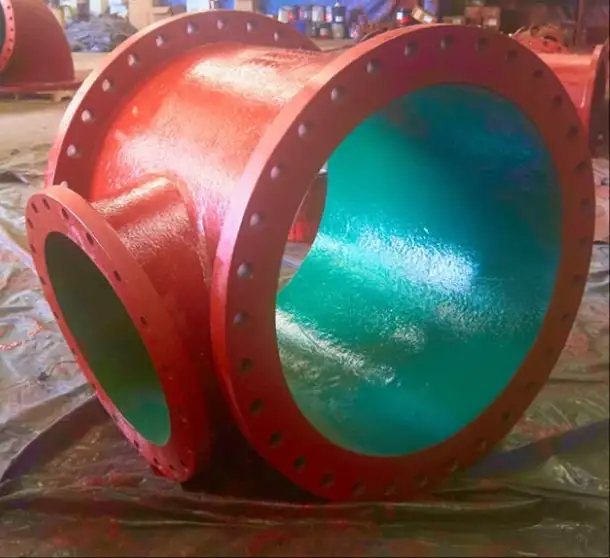Glass-lined ductile iron pipes are engineered to offer superior performance in challenging environments, particularly in wastewater and sewage systems. The fusion of ductile iron’s strength with the non-stick, corrosion-resistant properties of glass lining creates a piping solution that addresses common issues like scaling, clogging, and chemical degradation. This guide delves into the composition, applications, benefits, and maintenance of glass-lined ductile iron pipes.

🧪 Composition and Manufacturing Process
1. Ductile Iron Substrate
Ductile iron serves as the base material, chosen for its excellent tensile strength, impact resistance, and fatigue endurance. The centrifugal casting process ensures uniform wall thickness and structural integrity.
2. Glass Lining Application
The glass lining, typically a porcelain enamel, is applied to the interior surface of the ductile iron pipe. This process involves fusing a vitreous glass layer to the metal substrate at high temperatures, creating a seamless, non-porous, and chemically resistant surface.
🔍 Key Advantages
1. Corrosion Resistance
The glass lining provides an inert surface that resists corrosion from aggressive chemicals, acidic environments, and microbial activity, extending the pipe’s lifespan.
2. Non-Stick Surface
The smooth, non-stick interior reduces the accumulation of solids, grease, and scale, minimizing maintenance needs and ensuring consistent flow rates.
3. Abrasion Resistance
The hard glass surface withstands erosive forces, making it suitable for applications involving abrasive materials or high-velocity flows.
4. High Temperature Tolerance
Glass-lined pipes can endure elevated temperatures, making them ideal for industrial applications where heat resistance is crucial.
5. Environmental Compatibility
The materials used are non-toxic and environmentally friendly, aligning with sustainability goals and regulatory standards.
🛠️ Applications
Glass-lined ductile iron pipes are predominantly used in:
-
Wastewater Treatment Plants: Handling raw sewage, sludge, and scum.
-
Chemical Processing Industries: Transporting aggressive chemicals and acids.
-
Food and Beverage Processing: Managing viscous and sticky substances.
-
Pulp and Paper Mills: Dealing with abrasive slurries and high temperatures.
📊 Comparative Overview
| Feature | Glass-Lined Ductile Iron Pipe | Epoxy-Lined Ductile Iron Pipe | Cement-Mortar Lined Pipe |
|---|---|---|---|
| Corrosion Resistance | Excellent | Good | Moderate |
| Non-Stick Properties | High | Moderate | Low |
| Abrasion Resistance | High | Moderate | Low |
| Temperature Tolerance | High | Moderate | Low |
| Chemical Resistance | Excellent | Good | Poor |
| Maintenance Requirements | Low | Moderate | High |
🔍 Standards and Certifications
Glass-lined ductile iron pipes must comply with industry standards to ensure quality and performance:
-
ASTM B1000-15: Standard Specification for Glass-Lined Ductile Iron Pipe and Fittings.
-
NSF/ANSI 61: Drinking Water System Components – Health Effects.
-
AWWA C150/A21.50: Thickness Design of Ductile-Iron Pipe.
-
AWWA C151/A21.51: Ductile-Iron Pipe, Centrifugally Cast for Water.
🧰 Installation and Maintenance
Installation Guidelines
-
Handling: Use appropriate lifting equipment to prevent damage to the glass lining.
-
Joints: Ensure proper alignment and sealing of joints to maintain system integrity.
-
Support: Provide adequate support to prevent stress on the pipe during operation.
Maintenance Practices
-
Inspection: Regularly inspect for signs of damage or wear.
-
Cleaning: Use non-abrasive methods to clean the interior surface.
-
Repair: In case of damage, follow manufacturer guidelines for patching or recoating.
❓ Frequently Asked Questions (FAQs)
1. What is the lifespan of a glass-lined ductile iron pipe?
The lifespan of a glass-lined ductile iron pipe can exceed 50 years, depending on factors such as environmental conditions, maintenance practices, and operational parameters. Regular inspections and adherence to maintenance guidelines can help maximize the service life.
2. Can glass-lined ductile iron pipes be used for potable water systems?
Yes, glass-lined ductile iron pipes can be used for potable water systems, provided they meet the necessary health and safety standards, such as NSF/ANSI 61 certification. It’s essential to ensure that the materials used are non-toxic and do not leach harmful substances into the water supply.
3. How does the cost of glass-lined ductile iron pipe compare to other materials?
While the initial cost of glass-lined ductile iron pipe may be higher than some other materials, its durability, low maintenance requirements, and long service life often result in lower total cost of ownership over time. It’s important to consider the long-term benefits when evaluating cost-effectiveness.
4. What are the repair options if the glass lining is damaged?
If the glass lining is damaged, repair options include patching the affected area with compatible materials or, in some cases, recoating the entire pipe segment. It’s crucial to follow manufacturer guidelines and consult with professionals to ensure proper repair procedures are followed.
5. Are there any environmental considerations associated with glass-lined ductile iron pipes?
Glass-lined ductile iron pipes are considered environmentally friendly due to their longevity, recyclability, and the inert nature of the materials used. They help reduce the need for frequent replacements and minimize the environmental impact associated with pipe failures and maintenance activities.
🧭 Conclusion
Glass-lined ductile iron pipes offer a robust and reliable solution for challenging piping applications, combining the strength of ductile iron with the protective benefits of glass lining. Their resistance to corrosion, abrasion, and chemical degradation makes them suitable for a wide range of industries, including wastewater treatment, chemical processing, and food production. By adhering to installation and maintenance best practices, these pipes can provide decades of service, contributing to efficient and sustainable infrastructure.
References:
- Ductile Iron – Wikipedia
- ASTM B1000-15: Standard Specification for Glass-Lined Ductile Iron Pipe and Fittings – ASTM International
- AWWA Standards – American Water Works Association (AWWA)
- NSF/ANSI 61: Drinking Water System Components – Health Effects – NSF International
- FDA Food Labeling Guide – U.S. Food and Drug Administration (FDA)
